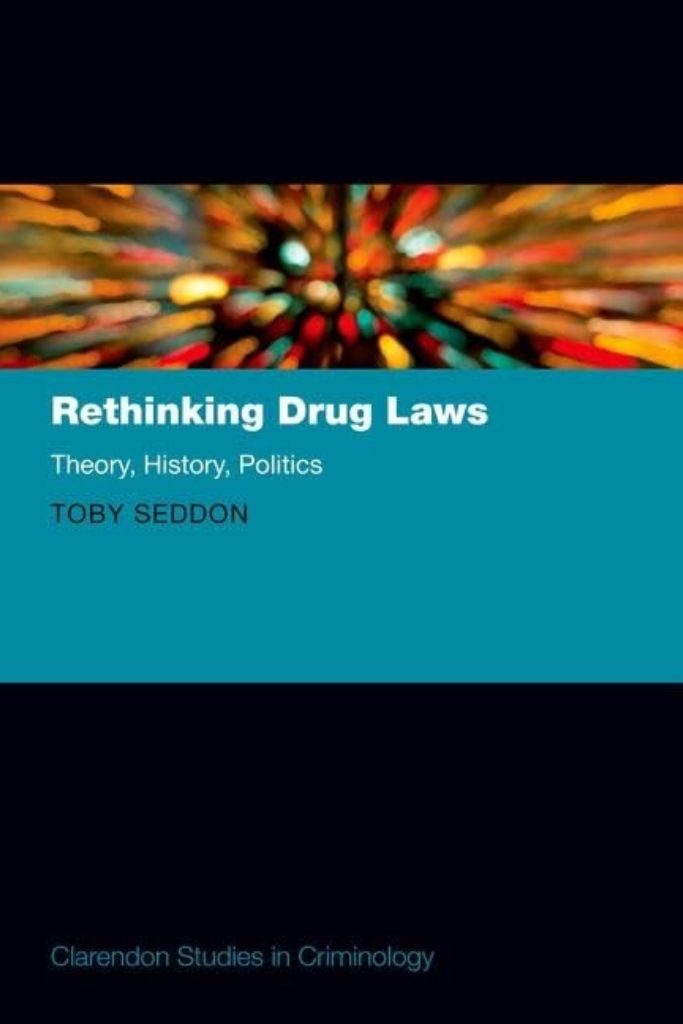In Rethinking Drug Laws: Theory, History, Politics, Toby Seddon analyses drug control policy and argues for a paradigm shift that decentres the West and recognises China’s historical and contemporary influence. Unpacking the complexity of drug law as a regulatory system, Seddon’s well-argued, insightful book calls for more inclusive, evidence-informed and democratic policymaking, writes Mark Monaghan.
Rethinking Drug Laws: Theory, History, Politics. Toby Seddon. Oxford University Press. 2023.
 Based on forensic archival research, Rethinking Drug Laws: Theory, History, Politics by Toby Seddon is beautifully written and deeply insightful. Its central thesis is that we must decentre the West, especially when thinking about the origins of drug policy. Viewing drug policy from a Western vantage point is a blip because, as Seddon shows, China has long been a key player on the global stage, but drug policy analysis, with some exceptions, has not always recognised this. In this way, drug policy analysis has fallen into the trap of Occidentalism, providing a distorted view of the West’s prominence. Seddon sets out to show the folly of this and succeeds. Furthermore, he demonstrates that there are signs of regression toward the mean as China once again is becoming a primary global player, particularly through the belt and road initiative.
Based on forensic archival research, Rethinking Drug Laws: Theory, History, Politics by Toby Seddon is beautifully written and deeply insightful. Its central thesis is that we must decentre the West, especially when thinking about the origins of drug policy. Viewing drug policy from a Western vantage point is a blip because, as Seddon shows, China has long been a key player on the global stage, but drug policy analysis, with some exceptions, has not always recognised this. In this way, drug policy analysis has fallen into the trap of Occidentalism, providing a distorted view of the West’s prominence. Seddon sets out to show the folly of this and succeeds. Furthermore, he demonstrates that there are signs of regression toward the mean as China once again is becoming a primary global player, particularly through the belt and road initiative.
In drug control, inanimate objects – drugs – are not banned, but transactions that would otherwise constitute lawful economic activity are criminalised.
A defining feature of Seddon’s writing is the remarkable capacity for distilling complex historical narratives into an easily digestible schema. We see this clearly in the introduction, where he proposes a tripartite structure of race, risk and security arcs as ways to think about the origins of what has only recently become known as the “drug problem”. We are also introduced to another key idea that drug laws function through controlling the circulation of goods, ie, they are regulatory systems. In drug control, inanimate objects – drugs – are not banned, but transactions that would otherwise constitute lawful economic activity are criminalised. This is about the control of personal property rights. The right to personal property is not explicitly eroded through prohibition, but some transactions in relation to them become impermissible and there is no legal recourse for the right to conduct these transactions. In outlining this, the entire premise of drug control shifts from one of a struggle between the forces of prohibition and legalisation to understanding legalisation and prohibition within a broader system of regulation.
Seddon refers to regulatory systems as ‘exchangespace’. […] The basic premise of exchangespace is that ‘market behaviour and regulation are not separate realms but two sides of the same coin’.
Seddon elaborates on this over the following chapters and in doing so demonstrates a depth of research and scholarship that is genuinely cross-disciplinary, bringing in economics, sociology, history, political economy as well as insights from criminology, regulation theory and socio-legal perspectives. There is, however, method to this, which shapes and is shaped by the development of a new conceptual framework. Drawing on the work of Clifford Shearing and others, Seddon refers to regulatory systems as “exchangespace”, and this is painstakingly outlined in Chapter Two. The basic premise of exchangespace is that “market behaviour and regulation are not separate realms but two sides of the same coin”. The dimensions of exchangespace can be summarised as:
- Regulation operates in networks consisting of multiple dimensions and participants.
- Nodes are a key element of networks and facilitate communication across them. Analysis of networks should, therefore, look at the nodes because these are the locus within a system where various resources are mobilised in order to govern effectively.
- Not all nodes exert the same amount or kind of power in the network. The most economically powerful nodes can distort the smooth operation of the entire system.
- Networks adapt overtime. Consequently, policy does not stand still, it evolves and emerges in often unpredictable ways.
Seddon encourages us to focus on the network conditions that led to increasing control of certain substances (what we know as drugs), whilst permitting or at least freeing the trade in others (coffee, alcohol and tobacco) and to view these as complex systems.
Seddon encourages us to focus on the network conditions that led to increasing control of certain substances (what we know as drugs), whilst permitting or at least freeing the trade in others (coffee, alcohol and tobacco) and to view these as complex systems. In complex systems, the outcomes of policy depend on understanding where the starting point is. However, identifying starting points is almost impossible, not least, as Seddon contends, because we don’t yet have the theory and methods at our disposal to do so. The best we can do, then, is to try and understand elements of the wider network; that is, which nodes are exerting power in which contexts while acknowledging that these systems are unpredictable and constantly changing. Seddon uses this framework to explain the origins of Cannabis Social Clubs in Catalonia and the complex politics behind the patchy implementation of Heroin Assisted Treatment. In this way, we can start to explain the ways in which, for example, overdose prevention centres have been established in some locations and not others, or why and how drugs were decriminalised in Oregon, a decision that may now be reversed.
Seddon demonstrates how the origins of the current system can be traced to colonialism […] in the nineteenth century, even if we cannot pinpoint the exact starting point.
A complex system like drug policy can never revert to an earlier stage of development. Oregon’s post-decriminalisation society will not be the same as its pre-decriminalisation society. Fortunately, however, complex systems do have path dependency, and so it is possible, as Seddon does in Part II (Chapters Four and Five), to outline the chain of events that has led to the contemporary global drug regulatory system. Seddon demonstrates how the origins of the current system can be traced to colonialism (the race arc) in the nineteenth century, even if we cannot pinpoint the exact starting point. The key lesson here is that we need to look East rather than West to understand this. Here, the Opium Wars of the nineteenth century are a key reference point.
Taking an exchangespace perspective we see that the Opium Wars (1839-1842) were more than just about one country (Britain) establishing a right to export its products (opium) to a large market (China). More accurately, they represented a military contestation that focused on the boundaries between legal and illegal trade – a contestation that lies at the heart of drug control. The burgeoning temperance movement proved a powerful node alongside increasingly powerful US economic interests, which contributed to the realigning of opium in the late nineteenth and early twentieth centuries as a product requiring control. The Opium Wars also represent – in the form of the second opium (Arrow) war – the first moment that drug control (as opium control) became a multinational affair. In this way we can draw a direct line from the Opium Wars to global drug prohibition fifty years later.
In Part III (Chapters Six and Seven) Seddon turns to the political nodes of the regulatory network, focusing on “what is at stake when drug laws and drug policy become a matter of political contestation”. The idea here is that within exchangespace, it is impossible to stand outside of politics, as the system is inherently political. Politics is a powerful node. This section draws heavily on Loader and Sparks’ conception of public criminology and the strategies that can be used to add coolant to heated debates.
To hand over decision making to experts is to abandon any hope for democratic politics as it replaces one system of domination (populist politics) with another (experts).
For Seddon, this should not simply mean that populist ideas – such as the “war on drugs” – are replaced with technocratic, evidence-based decisions. To hand over decision making to experts is to abandon any hope for democratic politics as it replaces one system of domination (populist politics) with another (experts). Arguably, that is why it has become more commonplace to speak of evidence-informed or evidence-inspired policy. However, Seddon provides a way out of that impasse by stating that “better politics” is required more than better evidence. This has two dimensions. First, we need a more careful analysis that focuses not only on the impact or harms of current drug policies (eg, criminalisation, stigmatisation, racist stereotyping) as they occur, but considers in depth and precision how the arcs of race, risk and security perpetuate this system. Secondly, on a practical level, a more cosmopolitan, comprehensive and inclusive deliberative democracy is required which can yield discernible change. Reforms in Catalonia and Oregon point to how this can be done, but also its precarity. Scaling it up and bringing in the voice of people who use drugs as part of a social movement is essential.
The text brings us almost full circle to how a better politics might lead to a more sophisticated, fairer form of market regulation.
Seddon points to the success of prison reform movements in France in the 1970s or the radical politics of mental health campaigning organisations which sought to foreground the voices of survivors of the psychiatric system as providing a blueprint. To this we could add decades of campaigning by disability rights activists, which have shown how positive change can occur with these strategies. There is no reason why drug policy should be any different. In this way, the text brings us almost full circle to how a better politics might lead to a more sophisticated, fairer form of market regulation. Ultimately, for Seddon, this means shifting the focus of social and political science away from the way the world is, towards the deeper thinking on the kind of world we want. This is the book’s challenge. It is us up to us to deliver.
Note: This interview gives the views of the author, and not the position of the LSE Review of Books blog, or of the London School of Economics and Political Science.
Image credit: OneSideProFoto on Shutterstock.







